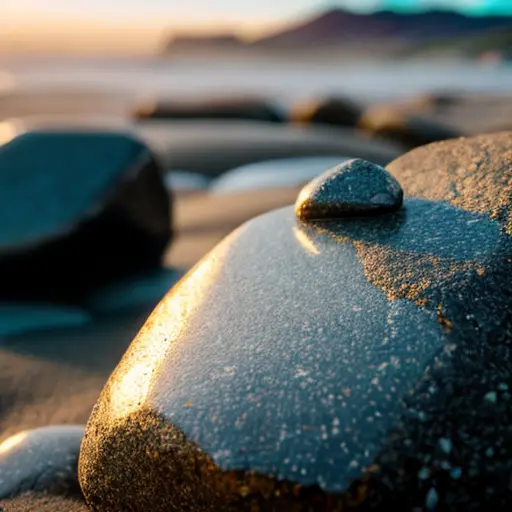Picture this: a seemingly innocent activity that has taken the world by storm - rock painting. It's all fun and games until you uncover the hidden environmental consequences lurking beneath the surface. Yes, my friends, I'm here to unveil the dark side of rock painting. As we merrily adorn these smooth stones with vibrant colors and cheerful messages, we often overlook the fact that we are tampering with nature's delicate balance. The innocent act of picking up rocks disrupts ecosystems, disturbs habitats, and can even lead to the extinction of certain species. So, next time you feel the urge to paint a rock, remember, you might just be contributing to the downfall of Mother Nature's rock-solid harmony.
While painting rocks may seem like a harmless and creative activity, it can actually have negative consequences for the environment. When rocks are painted, they lose their natural appearance and blend into their surroundings less effectively. This can disrupt the delicate balance of ecosystems, as animals and insects that rely on rocks for camouflage or shelter may be more easily spotted by predators. Additionally, the paint used in rock painting often contains harmful chemicals that can leach into the soil and water, posing a threat to plants, animals, and even humans. Therefore, it is important to appreciate the beauty of rocks in their natural state and avoid painting them to preserve the ecological harmony of our surroundings.
Imagine a world where rocks could speak. They would have tales to tell, stories of their place in the natural order of things. But alas, we humans have decided to disrupt this delicate balance by indulging in the seemingly harmless act of painting rocks. Little do we realize the ecological impact we are causing. By plucking these stones from their natural habitats, we disturb the intricate ecosystems that rely on them. From tiny insects to mosses and lichens, countless organisms call these rocks home. When we paint them, we disrupt their natural camouflage, making them more vulnerable to predators and throwing the delicate balance of nature off-kilter. So, let's think twice before we dip our brushes into nature's palette, for the consequences of our artistic endeavors may be far-reaching and detrimental to the very ecosystems we claim to admire.

In the whimsical world of rock painting, where creativity knows no bounds, it's easy to overlook the unintended consequences that may arise. One such consequence lies in the long-term effects of rock painting on wildlife. As we transform these natural canvases into vibrant works of art, we inadvertently disrupt the lives of countless creatures that rely on rocks for survival. From insects seeking shelter to reptiles basking in the sun's warmth, the painted rocks become a confusing and inhospitable environment. The camouflage that once protected them from predators is now compromised, leaving them vulnerable and exposed.
But it's not just the immediate impact that we should be concerned about. Over time, the accumulation of painted rocks in certain areas can lead to a significant alteration of wildlife habitats. As more and more rocks are taken from their natural settings, the balance of the ecosystem is disrupted. The absence of these rocks can affect the availability of food, nesting sites, and even breeding grounds for various species. This disruption can have a ripple effect throughout the food chain, ultimately impacting the overall biodiversity of the area.
Furthermore, the materials used in rock painting can have detrimental effects on wildlife. Many paints and sealants contain toxic chemicals that can leach into the surrounding environment, contaminating soil and water sources. As animals come into contact with these substances, they may suffer from poisoning or other health issues. Additionally, the discarded paintbrushes, empty paint cans, and other waste generated during the rock painting process can contribute to pollution and further harm wildlife.
It's crucial that we recognize the unintended consequences of our actions and consider the long-term effects of rock painting on wildlife. While the intention may be to spread joy and creativity, we must prioritize the preservation of natural habitats and the well-being of the creatures that call them home. Let's find alternative ways to express our artistic inclinations that do not disrupt the delicate balance of nature and ensure a harmonious coexistence with the wildlife around us.
Fun fact: Painting rocks may seem like a harmless and creative activity, but it can actually be harmful to the environment. When rocks are painted and left outside, the paint can eventually chip off and release harmful chemicals into the soil and water sources. These chemicals can have negative effects on plants, animals, and even humans. So, let's keep our rocks natural and beautiful, without any paint!
In our quest for self-expression and artistic endeavors, we often fail to recognize the threat that rock painting poses to environmental conservation and the preservation of natural beauty. As we pick up rocks and transform them into colorful masterpieces, we disrupt the inherent beauty of nature itself. These rocks, once part of the landscape's natural tapestry, are now altered and removed from their rightful place. This disruption not only diminishes the aesthetic appeal of the environment but also hinders the natural processes that have shaped it over time. By painting rocks, we inadvertently contribute to the erosion of the very essence that makes our surroundings so breathtaking. It's time to reconsider our artistic pursuits and find ways to appreciate and preserve the natural beauty that surrounds us, rather than altering it for our own fleeting enjoyment.